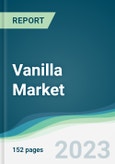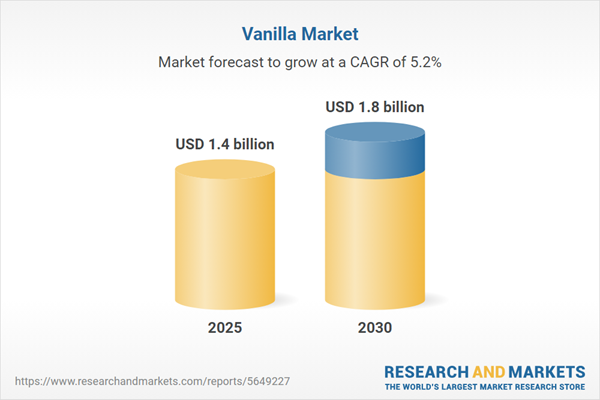The vanilla market is experiencing robust growth, driven by rising consumer demand for natural flavors, the expansion of the food and beverage sector, and increasing applications in health and wellness products. Vanilla’s appeal spans confectionery, dairy, and pharmaceutical industries, fueled by its use in premium and artisanal goods and its bioactive properties. Government initiatives, sustainable cultivation practices, and research advancements further propel the market.
Market Drivers
Government Initiatives and Research
Government programs and research efforts are pivotal in driving the vanilla market. In September 2023, the U.S. Agency for International Development (USAID) supported vanilla growers in Madagascar’s SAVA region, enhancing revenue and market access while promoting environmental sustainability through carbon sequestration initiatives. In October 2023, researchers at the University of Florida’s Tropical Research and Education Centre launched a comprehensive vanilla study, focusing on fertilizer guidelines, high-yielding and disease-resistant cultivars, and identifying beans with optimal vanillin content. Similarly, the United States Department of Agriculture (USDA) provided grants in 2023 to support University of Florida research, aiming to establish vanilla as a high-value crop for small farmers in southern Florida. These initiatives bolster domestic production and sustainable practices, driving market growth.Rising Demand Across Industries
The growing demand for natural vanilla in the food and beverage sector, particularly in bakery, confectionery, and dairy products like ice cream, is a significant market driver. Consumer preference for natural ingredients, spurred by health and wellness trends, has increased vanilla’s appeal in premium and artisanal products. Additionally, vanilla’s bioactive compounds, such as vanillin and vanillic acid, are recognized for their antibacterial properties, making it valuable in pharmaceuticals as an alternative or adjunct treatment for infections caused by multidrug-resistant bacteria like Enterococcus faecium and Staphylococcus aureus. The expanding use of vanilla in diverse applications, from food to cleaning solutions and candles, further fuels market growth.Sustainability and Premiumization Trends
The market is benefiting from a shift toward sustainable cultivation and premium products. Consumers’ preference for high-quality, ethically sourced vanilla aligns with the growing demand for artisanal goods. Innovations in sustainable practices and extraction techniques enhance vanilla’s commercial viability, addressing supply chain challenges and supporting market expansion. These trends cater to health-conscious consumers and environmentally aware markets, positioning vanilla as a versatile and high-value ingredient.Geographical Outlook
United States as a Growth Hub
The U.S. vanilla market is poised for steady growth, driven by increasing consumption of dairy products, coffee, and ice cream. The USDA’s 2023 initiatives to promote vanilla as a viable crop for small farmers in southern Florida highlight its potential as a high-value alternative to traditional crops. Research efforts at the University of Florida focus on developing disease-resistant varieties and optimizing yields, further supporting domestic production. The rising demand for natural and premium vanilla products, coupled with government support, positions the U.S. as a key growth market during the forecast period.Europe’s Significant Market Share
Europe remains a major market for vanilla, with countries like France, Germany, and the Netherlands accounting for a substantial portion of global imports. The region’s strong food and beverage industry, driven by consumer demand for natural and premium flavors, supports market growth. The emphasis on sustainable sourcing and high-quality products aligns with Europe’s regulatory and consumer trends, ensuring continued demand for vanilla in confectionery, bakery, and health-focused applications.Key Developments
In October 2023, Rodelle expanded its market presence in Canada through a partnership with Walmart, offering Fairtrade Organic Pure Madagascar Bourbon Vanilla Extract and Vanilla Bean Paste in 227 retail locations from Quebec to Vancouver. This move reflects the growing consumer demand for premium, ethically sourced vanilla products and underscores the market’s competitive landscape driven by innovation and accessibility.The vanilla market is on a strong growth trajectory, propelled by consumer demand for natural flavors, the expansion of the food and beverage sector, and the increasing use of vanilla in health and pharmaceutical applications. Government initiatives, such as USAID’s support in Madagascar and USDA-funded research in the U.S., alongside sustainable cultivation practices, are key growth catalysts. The U.S. and Europe lead as major markets, driven by premiumization and health trends. With ongoing innovations and research, the vanilla market is well-positioned for sustained expansion, catering to diverse industries and consumer preferences during the forecast period.
Key Benefits of this Report:
- Insightful Analysis: Gain detailed market insights covering major as well as emerging geographical regions, focusing on customer segments, government policies and socio-economic factors, consumer preferences, industry verticals, and other sub-segments.
- Competitive Landscape: Understand the strategic maneuvers employed by key players globally to understand possible market penetration with the correct strategy.
- Market Drivers & Future Trends: Explore the dynamic factors and pivotal market trends and how they will shape future market developments.
- Actionable Recommendations: Utilize the insights to exercise strategic decisions to uncover new business streams and revenues in a dynamic environment.
- Caters to a Wide Audience: Beneficial and cost-effective for startups, research institutions, consultants, SMEs, and large enterprises.
What do businesses use these reports for?
Industry and Market Insights, Opportunity Assessment, Product Demand Forecasting, Market Entry Strategy, Geographical Expansion, Capital Investment Decisions, Regulatory Framework & Implications, New Product Development, Competitive IntelligenceReport Coverage:
- Historical data from 2022 to 2024 & forecast data from 2025 to 2030
- Growth Opportunities, Challenges, Supply Chain Outlook, Regulatory Framework, and Trend Analysis
- Competitive Positioning, Strategies, and Market Share Analysis
- Revenue Growth and Forecast Assessment of segments and regions including countries
- Company Profiling (Strategies, Products, Financial Information, and Key Developments among others.
Segmentation
By Origin
- Natural
- Synthetic
By Form
- Beans
- Extract
- Paste
- Others
By End-User Industry
- Food and Beverages
- Personal Care
- Pharmaceuticals
- Others
By Distribution Channel
- Online
- Offline
By Geography
- North America
- USA
- Canada
- Mexico
- South America
- Brazil
- Argentina
- Others
- Europe
- Germany
- France
- United Kingdom
- Spain
- Others
- Middle East and Africa
- Saudi Arabia
- UAE
- Others
- Asia Pacific
- China
- India
- Japan
- South Korea
- Indonesia
- Thailand
- Others
Table of Contents
Companies Mentioned
- Hawaiian Vanilla Company
- Nielsen-Massey Vanillas, Inc.
- Eurovanille
- Symrise
- Indovanili
- Pure Vanilla Madagascar
- Vanilla Impex
- The Mad Spice Company
- Laie Vanilla Company
Table Information
| Report Attribute | Details |
|---|---|
| No. of Pages | 152 |
| Published | August 2025 |
| Forecast Period | 2025 - 2030 |
| Estimated Market Value ( USD | $ 1.4 billion |
| Forecasted Market Value ( USD | $ 1.8 billion |
| Compound Annual Growth Rate | 5.1% |
| Regions Covered | Global |
| No. of Companies Mentioned | 9 |









